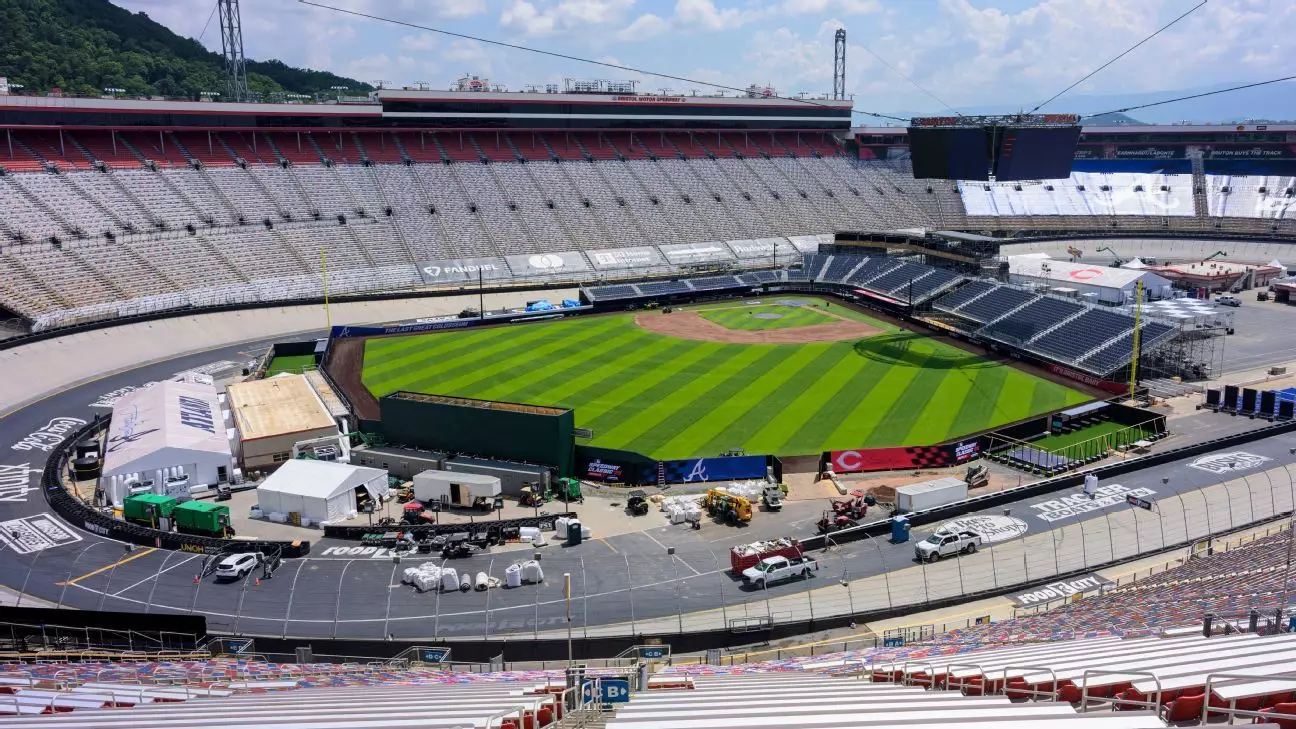Bristol Motor Speedway, long celebrated as one of NASCAR’s crown jewels, recently embarked on an unprecedented adventure—converting its legendary racetrack into a vibrant baseball diamond. This rapid transformation not only showcases the versatility of this historic venue but also underscores the growing trend of multi-purpose sporting arenas. The challenge was formidable: deconstructing a racetrack designed solely for speed and adrenaline, then reconstructing a state-of-the-art baseball field capable of hosting over 90,000 spectators. Yet, this challenge was embraced eagerly, driven by a desire to push boundaries and redefine what a sports venue can be.
The process was nothing short of extraordinary. Major League Baseball invested heavily in the venue, constructing custom clubhouses, batting cages, and broadcast booths, all nestled within the familiar Bristol backdrop. Over 17,500 tons of gravel and 340 tons of Pennsylvania clay laid the groundwork for the infield, demonstrating the scale and precision required for such a transition. The significant logistical effort involved in tearing down and rebuilding structures—pit walls, grandstands, and infrastructure—needed meticulous planning and swift execution, especially with a tight schedule. The rapid changeover exemplifies a commitment to innovation, turning what could be saw as a logistical nightmare into an inspiring display of engineering mastery.
One cannot ignore the emotional and historical significance attached to Bristol’s switch from a racing icon to a baseball stadium. Historically, the track has hosted some of the most intense and memorable NASCAR events, providing decades of adrenaline-fueled entertainment. Now, the venue at the cusp of a new chapter—an ode to adaptability and resilience. While the schedule looks tight, with a target completion date set just days before the NASCAR playoff race, the organizers’ confidence signals a broader message: sports venues are not fixed in purpose—they evolve with the times, constantly reinventing themselves to accommodate new audiences and sporting innovations.
Balancing Heritage with Innovation: The Challenges and Opportunities
The transition at Bristol raises critical questions about the sustainability and practicality of multi-use sports venues. While the spectacle of hosting both baseball and NASCAR at the same location is undeniably exciting, the logistical hurdles are immense. Construction activities such as pouring concrete, leveling the infield, and rebuilding grandstands demand patience and expertise. The rapid turnaround also necessitates careful planning; Swift and his team are working tirelessly to ensure that the venue’s transformation does not compromise safety or quality.
Interestingly, some materials used during the baseball setup are being repurposed to aid in community rebuilding efforts—materials like gravel, plywood, and 2x4s are being donated for Hurricane Helene relief efforts. This thoughtful approach highlights a broader social consciousness, reflecting an acknowledgment of the venue’s role beyond entertainment. It exemplifies how sports infrastructure can serve a dual purpose: providing entertainment and contributing to community resilience.
The potential for such a venue extends beyond these two sports. Reports suggest that NHL officials are already evaluating Bristol’s capacity as a versatile entertainment hub. This openness to hosting a diverse array of sporting events speaks to a future where stadiums are not one-trick ponies but multifunctional hubs that adapt to changing demands and audience preferences. That kind of flexibility is daunting but necessary in the modern sports landscape, where innovation often dictates long-term relevance.
Challenging Perceptions and Expanding Horizons
Bristol’s foray into hosting baseball—an endeavor that drew over 91,000 paying fans—is a testament to the stadium’s capacity to challenge traditional perceptions. Historically, Bristol has been instrumental in shaping NASCAR’s identity, a symbol of speed and ruggedness. Now, it stands at the intersection of innovation and tradition, proving that sports venues can be more than just one-dimensional spaces.
The success of this transformation could pave the way for similar venues to reconsider their roles within their communities. Furthermore, it invites a broader conversation about the potential for stadiums to host cultural, entertainment, and even emergency services, becoming flexible fixtures in local development. This willingness to experiment reflects a proactive attitude towards growth—an attitude that could redefine the future of sports infrastructure worldwide.
Bristol’s daring approach exemplifies a larger truth: embracing change, no matter how daunting, often leads to extraordinary opportunities. The venue’s capability to switch from hosting college football crowds of nearly 157,000 to accommodating a major league baseball game—and potentially beyond—demonstrates an impressive level of adaptability. It suggests that the arena of sports is not static but a dynamic landscape where innovation is the key to staying relevant and engaging for diverse audiences.
In a time when the sports industry frequently grapples with issues of sustainability, innovation, and community engagement, Bristol’s transformation stands out as a bold blueprint. It underscores the importance of resilience and creativity, inspiring other venues to rethink their potential and consider new ways to serve their communities and sporting worlds alike.


Leave a Reply